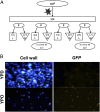Role of social wasps in Saccharomyces cerevisiae ecology and evolution
- PMID: 22847440
- PMCID: PMC3421210
- DOI: 10.1073/pnas.1208362109
Role of social wasps in Saccharomyces cerevisiae ecology and evolution
Abstract
Saccharomyces cerevisiae is one of the most important model organisms and has been a valuable asset to human civilization. However, despite its extensive use in the last 9,000 y, the existence of a seasonal cycle outside human-made environments has not yet been described. We demonstrate the role of social wasps as vector and natural reservoir of S. cerevisiae during all seasons. We provide experimental evidence that queens of social wasps overwintering as adults (Vespa crabro and Polistes spp.) can harbor yeast cells from autumn to spring and transmit them to their progeny. This result is mirrored by field surveys of the genetic variability of natural strains of yeast. Microsatellites and sequences of a selected set of loci able to recapitulate the yeast strain's evolutionary history were used to compare 17 environmental wasp isolates with a collection of strains from grapes from the same region and more than 230 strains representing worldwide yeast variation. The wasp isolates fall into subclusters representing the overall ecological and industrial yeast diversity of their geographic origin. Our findings indicate that wasps are a key environmental niche for the evolution of natural S. cerevisiae populations, the dispersion of yeast cells in the environment, and the maintenance of their diversity. The close relatedness of several wasp isolates with grape and wine isolates reflects the crucial role of human activities on yeast population structure, through clonal expansion and selection of specific strains during the biotransformation of fermented foods, followed by dispersal mediated by insects and other animals.
Conflict of interest statement
The authors declare no conflict of interest.
Figures




References
-
- Cavalieri D, McGovern PE, Hartl DL, Mortimer R, Polsinelli M. Evidence for S. cerevisiae fermentation in ancient wine. J Mol Evol. 2003;57(Suppl 1):S226–S232. - PubMed
-
- Teresa Fernández-Espinar M, Barrio E, Querol A. Analysis of the genetic variability in the species of the Saccharomyces sensu stricto complex. Yeast. 2003;20:1213–1226. - PubMed
-
- Veiga-Crespo P, Poza M, Prieto-Alcedo M, Villa TG. Ancient genes of Saccharomyces cerevisiae. Microbiology. 2004;150:2221–2227. - PubMed
Publication types
MeSH terms
Associated data
- Actions
- Actions
- Actions
- Actions
- Actions
- Actions
- Actions
- Actions
- Actions
- Actions
- Actions
- Actions
- Actions
- Actions
- Actions
- Actions
- Actions
- Actions
- Actions
- Actions
- Actions
- Actions
- Actions
- Actions
- Actions
- Actions
- Actions
- Actions
- Actions
- Actions
- Actions
- Actions
- Actions
- Actions
- Actions
- Actions
- Actions
- Actions
- Actions
- Actions
- Actions
- Actions
- Actions
- Actions
- Actions
- Actions
- Actions
- Actions
- Actions
- Actions
- Actions
- Actions
- Actions
- Actions
- Actions
- Actions
- Actions
- Actions
- Actions
- Actions
- Actions
- Actions
- Actions
- Actions
- Actions
- Actions
- Actions
- Actions
- Actions
- Actions
- Actions
- Actions
- Actions
- Actions
- Actions
- Actions
- Actions
- Actions
- Actions
- Actions
- Actions
- Actions
- Actions
- Actions
- Actions
- Actions
- Actions
- Actions
- Actions
- Actions
LinkOut - more resources
Full Text Sources
Molecular Biology Databases
Miscellaneous

